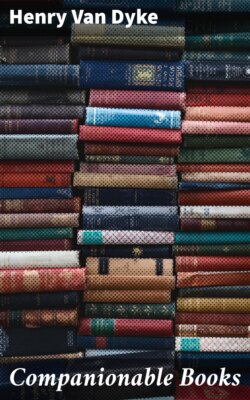Читать книгу Companionable Books - Henry Van Dyke - Страница 15
На сайте Литреса книга снята с продажи.
ОглавлениеO come let us sing unto the Lord;
Let us make a joyful noise to the rock of our salvation,
Let us come before his presence with thanksgiving;
And make a joyful noise unto him with psalms.
If we should want a plain English name for this method of composition we might call it thought-rhyme. It is easy to find varied illustrations of its beauty and of its power to emphasize large and simple ideas.
Take for instance that very perfect psalm with which the book begins—a poem so complete, so compact, so delicately wrought that it seems like a sonnet. The subject is The Two Paths.
The first part describes the way of the good man. It has three divisions.
The first verse gives a description of his conduct by negatives—telling us what he does not do. There is a triple thought-rhyme here.
Blessed is the man that walketh not in the counsel of the ungodly,
Nor standeth in the way of sinners,
Nor sitteth in the seat of the scornful.
The second verse describes his character positively, with a double thought-rhyme.
But his delight is in the law of the Lord;
And in his law doth he meditate day and night.
The third verse tells us the result of this character and conduct, in a fourfold thought-rhyme.
He shall be like a tree planted by the rivers of water:
That bringeth forth his fruit in his season:
His leaf also shall not wither:
And whatsoever he doeth shall prosper.
The second part of the psalm describes the way of the evil man. In the fourth verse there is a double thought-rhyme.
The ungodly are not so:
But are like the chaff which the wind driveth away.
In the fifth verse the consequences of this worthless, fruitless, unrooted life are shown, again with a double cadence of thought, the first referring to the judgment of God, the second to the judgment of men.
Therefore the ungodly shall not stand in the judgment:
Nor sinners in the congregation of the righteous.
The third part of the psalm is a terse, powerful couplet, giving the reason for the different ending of the two paths.
For the Lord knoweth the way of the righteous:
But the way of the ungodly shall perish.
The thought-rhyme here is one of contrast.
A poem of very different character from this brief, serious, impersonal sonnet is found in the Forty-sixth Psalm, which might be called a National Anthem. Here again the poem is divided into three parts.
The first part (verses first to third) expresses a sense of joyful confidence in the Eternal, amid the tempests and confusions of earth. The thought-rhymes are in couplets; and the second phrase, in each case, emphasizes and enlarges the idea of the first phrase.
God is our refuge and strength:
A very present help in trouble.
The second part (verses fourth to seventh) describes the peace and security of the city of God, surrounded by furious enemies, but rejoicing in the Eternal Presence. The parallel phrases here follow the same rule as in the first part. The concluding phrase is the stronger, the more emphatic. The seventh verse gives the refrain or chorus of the anthem.
The Lord of hosts is with us:
The God of Jacob is our refuge.
The last part (verses eighth to tenth) describes in a very vivid and concrete way the deliverance of the people that have trusted in the Eternal. It begins with a couplet, like those which have gone before. Then follow two stanzas of triple thought-rhymes, in which the thought is stated and intensified with each repetition.
He maketh wars to cease unto the end of the earth:
He breaketh the bow, and cutteth the spear in sunder:
He burneth the chariot in the fire.
Be still, and know that I am God:
I will be exalted among the heathen:
I will be exalted in the earth.
The anthem ends with a repetition of the refrain.
A careful study of the Psalms, even in English, will enable the thoughtful reader to derive new pleasure from them, by tracing the many modes and manners in which this poetic form of thought-rhyme is used to bind the composition together, and to give balance and harmony to the poem.
Another element of poetic form can be discerned in the Psalms, not directly, in the English version, but by its effects. I mean the curious artifice of alphabetic arrangement. It was a favourite practice among Hebrew poets to begin their verses with the successive letters of the alphabet, or sometimes to vary the device by making every verse in a strophe begin with one letter, and every verse in the next strophe with the following letter, and so on to the end. The Twenty-fifth and the Thirty-seventh Psalms were written by the first of these rules; the One Hundred and Nineteenth Psalm follows the second plan.
Of course the alphabetic artifice disappears entirely in the English translation. But its effects remain. The Psalms written in this manner usually have but a single theme, which is repeated over and over again, in different words and with new illustrations. They are kaleidoscopic. The material does not change, but it is turned this way and that way, and shows itself in new shapes and arrangements. These alphabetic psalms are characterized by poverty of action and richness of expression.
